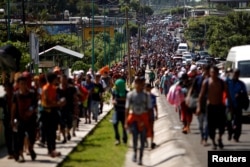Mexico's incoming foreign minister Marcelo Ebrard said on Tuesday that to contain migration pressure in Central America and southern Mexico, an effort on the scale of the Marshall Plan that rebuilt war-ravaged Europe would be needed to develop the region.
Mexico is battling to curb the flow of migrants from Central America fleeing violence and poverty, and tensions have risen on the U.S.-Mexico border since the arrival in the last few weeks of a caravan of mostly Hondurans seeking U.S. asylum.
Mexican President-elect Andres Manuel Lopez Obrador has pledged to discourage migration through economic development, and wants the United States to contribute to a plan focused on Mexico's poorer south and Central America.
Speaking in Mexico City, Ebrard said the solution might not be similar to the Marshall Plan, "but it will be in terms of the scale of the effort that needs to be made," he told reporters.
Named after U.S. general and later Secretary of State George Marshall, the Marshall Plan was a massive U.S.-backed effort to rebuild Western Europe after the devastation wrought by World War II.
Ebrard, who is due to meet U.S. Secretary of State Mike Pompeo on Sunday to discuss the border and migration, said estimates were still being prepared to determine just how much funding would be needed to develop the region.
Mexico alone was likely to invest more than $20 billion in southern Mexico during the coming administration, Ebrard said.
"As a result, any serious effort undertaken for our brothers in El Salvador, Honduras and Guatemala would need to be a similar sum," he added.
The bulk of illegal immigrants caught trying to enter the United States in recent years have set out from Honduras, El Salvador and Guatemala, three of the most violent and impoverished countries in the Americas.
U.S. President Donald Trump has been pressuring Mexico to keep the migrants while their asylum claims are processed in the United States. Members of the incoming government have suggested some sort of deal may be possible.
Ebrard said Mexico was not thinking of deporting the Central American migrants currently stuck on the U.S. border.
"What's to be done? Get ready to assume that some of them are going to be on Mexican soil and in that area during the next few months," he said.












